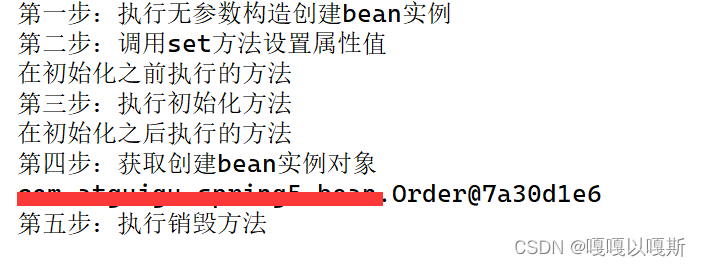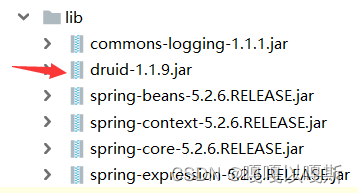提示:文章写完后,目录可以自动生成,如何生成可参考右边的帮助文档
文章目录
前言
学习Spring课程,记下笔记~
IOC(控制反转)部分
一、IOC
1.什么是IOC
1.概念:IOC(Inversion of Control),控制反转,把对象创建和对象之间的调用过程,交给Spring进行管理。
2.目的:降低耦合度
3.底层原理:xml解析、工厂模式、反射
//第一步 xml配置文件,配置创建的对象
<bean id="dao" class="com.ncst.UserDao"></bean>
//第二步 有service类和dao类,创建工厂类
class UserFactory{
public static UserDao getDao(){
//1. xml解析
String classValue=class属性值;
//2.通过反射创建对象
Class clazz=Class.forName(classValue);
return (UserDao)clazz.newInstance();
}
}
2. IOC 接口
- IOC思想基于IOC容器完成,IOC容器底层就是对象工厂
- Spring提供IOC容器实现两种方式:(两个接口)
(1) BeanFactory: IOC容器基本实现,是Spring内部的使用接口,不提供开发人员使用
*加载配置文件时候不会创建对象,在获取对象(使用)才去创建对象
(2)ApplilcationContext: BeanFactory接口的子接口,提供更多更轻大的功能,一般由开发人员进行使用
*加载配置文件时候就会把在配置文件对象进行创建
3. IOC操作——Bean管理
3.1 概念
1.什么是Bean管理
(a)Spring创建对象
(b)Spring注入属性
2.Bean管理操作的方式
(a)基于xml配置文件方式实现
(b)基于注解方式实现
3.2基于xml配置文件方式
3.2.1 创建对象
<!--配置User对象-->
<bean id="user" class="com.ncst.Spring5.User"></bean>
(1)在Spring配置文件中,使用bean标签,标签里面添加对应属性,就可以实现对象创建
(2)在bean标签有很多属性,介绍常用的属性:
*id属性:唯一标识
*class属性:类全路径(包类路径)
(3)创建对象时候,默认是执行无参数构造方式完成对象创建
3.2.2 注入属性
(a)使用set方式注入
(a.1)创建类,定义属性和对应的set方法
/**
* 演示使用set方法进行注入属性
*
*/
public class Book {
//创建属性
private String bname;
private String bauthor;
//创建属性对应的set方法
public void setBname(String bname) {
this.bname = bname;
}
public void setBauthor(String bauthor) {
this.bauthor = bauthor;
}
}
(a.2)在Spring配置文件中配置对象创建,配置属性注入
<!--2 set方法注入属性-->
<bean id="book" class="com.ncst.spring5.Book">
<!--使用property完成属性注入
name:类里面属性名称
value:向属性注入的值
-->
<property name="bname" value="易筋经"></property>
<property name="bauthor" value="达摩老祖"></property>
</bean>
(b)使用有参数构造注入
(b.1)创建类,定义属性,创建属性对应的有参数构造方法
/**
* 有参数构造注入属性
*/
public class Orders {
//创建属性
private String oname;
private String address;
//有参数构造
public Orders(String oname, String address) {
this.oname = oname;
this.address = address;
}
}
(b.2)在Spring配置文件中进行配置
<!--3 有参构造注入属性-->
<bean id="orders" class="com.ncst.spring5.Orders">
<constructor-arg name="oname" value="电脑"></constructor-arg>
<constructor-arg name="address" value="China"></constructor-arg>
</bean>
(c)使用P名称空间注入 (简化基于xml配置方式)
(c.1)添加p名称空间在配置文件中
xmlns:p=“http://www.springframework.org/schema/p”
<?xml version="1.0" encoding="UTF-8"?>
<beans xmlns="http://www.springframework.org/schema/beans"
xmlns:xsi="http://www.w3.org/2001/XMLSchema-instance"
xmlns:p="http://www.springframework.org/schema/p"
xsi:schemaLocation="http://www.springframework.org/schema/beans http://www.springframework.org/schema/beans/spring-beans.xsd">
(c.2)进行属性注入,在bean标签里面进行操作
<bean id="book" class="com.ncst.spring5.Book" p:bname="九阳神功" p:bauthor="无名氏"></bean>
(d)注入字面量属性
(d.1)null值
<!--设置null-->
<property name="address">
<null/>
</property>
(d.2)属性值包含特殊符号
<!--属性值包含特殊符号
1.把<>进行转义 < >
2.把带特殊符号内容写到 CDATA
-->
<property name="address">
<value> <![CDATA[<<南京>>]]> </value>
</property>
(e)注入属性–外部bean
(e.1)创建两个类service类和dao类
(e.2)在service调用dao里面的方法
(e.3)在spring配置文件中进行配置
public class UserService {
//创建UserDao类型属性,生成set方法
private UserDao userDao;
public void setUserDao(UserDao userDao) {
this.userDao = userDao;
}
public void add(){
System.out.println("Service add·········");
userDao.update();
//原始方式:创建UserDao对象
// UserDao userDao=new UserDaoImpl();
// userDao.update();
}
}
<!--1 service和dao对象的创建-->
<bean id="userService" class="com.ncst.spring5.service.UserService">
<!--注入userDao对象
name属性:类里面属性名称
ref属性:创建userDao对象bean标签id值
-->
<property name="userDao" ref="userDaoImpl"></property>
</bean>
<bean id="userDaoImpl" class="com.ncst.spring5.dao.UserDaoImpl"></bean>
(f)注入属性–内部bean
一对多关系:部门和员工
一个部门有多个员工,一个员工属于一个部门
部门是一,员工是多
(f.1)在实体类之间表示一对多关系,员工表示所属部门,使用对象类型属性进行表示
//部门类
public class Dept {
private String dname;
public void setDname(String dname) {
this.dname = dname;
}
}
//员工类
public class Emp {
private String ename;
private String gender;
//员工属于某一个部门,使用对象形式表示
private Dept dept;
public void setDept(Dept dept) {
this.dept = dept;
}
public void setEname(String ename) {
this.ename = ename;
}
public void setGender(String gender) {
this.gender = gender;
}
}
(f.2)在Spring配置文件中进行配置
<!--内部bean-->
<bean id="emp" class="com.ncst.spring5.bean.Emp">
<!--设置两个普通属性-->
<property name="ename" value="lucy"></property>
<property name="gender" value="女"></property>
<!--设置对象类型属性-->
<property name="dept">
<bean id="dept" class="com.ncst.spring5.bean.Dept">
<property name="dname" value="安保部"></property>
</bean>
</property>
</bean>
(g)注入属性–级联赋值
(g.1)方式一
<!--级联赋值-->
<bean id="emp" class="com.ncst.spring5.bean.Emp">
<!--设置两个普通属性-->
<property name="ename" value="lilei"></property>
<property name="gender" value="男"></property>
<!--级联赋值-->
<!--第一种写法-->
<property name="dept" ref="dept"></property>
</bean>
<bean id="dept" class="com.ncst.spring5.bean.Dept">
<property name="dname" value="财务部"></property>
</bean>
(g.2)方式二
//员工属于某一个部门,使用对象形式表示
private Dept dept;
//生成dept的get方法
public Dept getDept() {
return dept;
}
<!--级联赋值-->
<bean id="emp" class="com.ncst.spring5.bean.Emp">
<!--设置两个普通属性-->
<property name="ename" value="lilei"></property>
<property name="gender" value="男"></property>
<!--级联赋值-->
<!--第二种写法 需要提前在Emp.class中的dept设置get方法-->
<property name="dept.dname" value="技术部"></property>
</bean>
(h)注入集合属性
(h.1)创建类,定义数组、list、map、set类型属性,生成对应的set方法
public class Stu {
//1.数组类型属性
private String[] courses;
//2.List集合类型属性
private List<String> list;
//3.Map集合类型属性
private Map<String,String> maps;
//4.set集合类型属性
private Set<String> sets;
//5.List集合(对象类型)
private List<Course> courseList;
public void setCourseList(List<Course> courseList) {
this.courseList = courseList;
}
public void setCourses(String[] courses) {
this.courses = courses;
}
public void setList(List<String> list) {
this.list = list;
}
public void setMaps(Map<String, String> maps) {
this.maps = maps;
}
public void setSets(Set<String> sets) {
this.sets = sets;
}
(h.2)在spring配置文件中进行配置
<!--集合类型属性注入-->
<bean id="stu" class="com.ncst.spring5.collectiontype.Stu">
<!--1.数组类型属性注入-->
<property name="courses">
<array>
<value>java课程</value>
<value>数据库课程</value>
</array>
</property>
<!--2.List类型属性注入-->
<property name="list">
<list>
<value>张三</value>
<value>李四</value>
</list>
</property>
<!--3.map类型属性注入-->
<property name="maps">
<map>
<entry key="JAVA" value="java"></entry>
<entry key="PHP" value="php"></entry>
</map>
</property>
<!--4.set类型属性注入-->
<property name="sets">
<set>
<value>MySql</value>
<value>Redis</value>
</set>
</property>
<!--5.注入list类型属性,值是对象-->
<property name="courseList">
<list>
<ref bean="course1"></ref>
<ref bean="course2"></ref>
</list>
</property>
</bean>
<!--创建多个course对象-->
<bean id="course1" class="com.ncst.spring5.collectiontype.Course">
<property name="cname" value="Spring5框架"></property>
</bean>
<bean id="course2" class="com.ncst.spring5.collectiontype.Course">
<property name="cname" value="MyBatis框架"></property>
</bean>
(i)把集合注入部分提取出来
(i.1)在spring配置文件中引入名称空间 util
<?xml version="1.0" encoding="UTF-8"?>
<beans xmlns="http://www.springframework.org/schema/beans"
xmlns:xsi="http://www.w3.org/2001/XMLSchema-instance"
xmlns:util="http://www.springframework.org/schema/util"
xsi:schemaLocation="http://www.springframework.org/schema/beans http://www.springframework.org/schema/beans/spring-beans.xsd
http://www.springframework.org/schema/util http://www.springframework.org/schema/util/spring-util.xsd">
(i.2)使用util标签完成list集合注入提取
<!--1 提取list集合类型属性注入-->
<util:list id="bookList">
<value>易筋经</value>
<value>九阴真经</value>
<value>九阳神功</value>
</util:list>
<!--2 提取list集合类型属性注入使用-->
<bean id="book" class="com.ncst.spring5.collectiontype.Book">
<property name="list" ref="bookList"></property>
</bean>
3.3基于注解方式实现
3.3.0 注解相关概念
1.什么是注解?
(1)注解是代码特殊标记,格式:@注解名称(属性名称=属性值,属性名称=属性值…)
(2)使用注解,注解作用在类上面、方法上面、属性上面
(3)使用注解的目的:简化xml配置
2.Spring针对Bean管理中创建对象提供注解
@Component
@Service
@Controller
@Repository
*上述四个注解功能一样,都可以用来创建bean实例
3.3.1 创建对象
(1)引入依赖

(2)开启组件扫描
<!--开启组件扫描
1.如果扫描多个包,多个包使用逗号隔开
2.扫描包上层目录
-->
<context:component-scan base-package="com.atguigu.spring5.dao,com.atguigu.spring5.service"></context:component-scan>
(3)创建类,在类上面添加创建对象注解
//在注解里面value属性值可以省略不写
//默认值是类名称,首字母小写
//UserService--userService
@Component(value = "userService") //<bean id="userService" class=".." />
public class UserService {
public void add(){
System.out.println("add....");
}
}
3.3.2注入属性
(a)@Autowire:根据属性类型进行自动装配
(a.1)把service和dao对象创建,在service和dao类添加创建对象注解
(a.2)在service注入dao对象,在service类添加dao类型属性,在属性上面使用注解
@Service
public class UserService {
//定义 dao 类型属性
//不需要添加 set 方法
//添加注入属性注解
@Autowired
private UserDao userDao;
public void add() {
System.out.println("service add.......");
userDao.add();
}
}
(b)@Qualifier:根据名称进行注入
这个@Qualifier注解的使用,和上面@Autowire一起使用
//定义 dao 类型属性
//不需要添加 set 方法
//添加注入属性注解
@Autowired //根据类型进行注入
@Qualifier(value = "userDaoImpl1") //根据名称进行注入
private UserDao userDao;
(c)@Resource:可以根据类型注入,也可以根据名称注入
//@Resource //根据类型进行注入
@Resource(name = "userDaoImpl1") //根据名称进行注入
private UserDao userDao;
(d)@Value:注入普通类型属性
@Value(value = "abc")
private String name;
4. IOC操作Bean管理——FactoryBean
1.Spring中有两种类型bean,一种普通bean,另外一种工厂bean(FactoryBean)
普通bean:在配置文件中定义的bean类型就是返回类型
工厂bean:在配置文件中定义的bean类型可以和返回类型不一样
2.实例:
第一步:创建类,让这个类作为工厂bean,实现接口FactoryBean
第二步:实现接口里面的方法,在实现的方法中定义返回的bean类型
public class MyBean implements FactoryBean<Course> {
//定义返回bean
@Override
public Course getObject() throws Exception {
Course course=new Course();
course.setCname("abc");
return course;
}
@Override
public Class<?> getObjectType() {
return null;
}
@Override
public boolean isSingleton() {
return false;
}
}
<bean id="myBean" class="com.ncst.spring5.factorybean.MyBean">
</bean>
@Test
public void test3(){
ApplicationContext context=new
ClassPathXmlApplicationContext("bean3.xml");
Course course = context.getBean("myBean", Course.class);
System.out.println(course);
}
5. IOC操作Bean管理——bean作用域
1.在Spring里面,默认情况下,bean是单实例对象

2.如何设置单实例还是多实例
(1)在spring配置文件bean标签里面有属性(scope)用于设置单实例还是多实例
(2)scope属性值
第一个值 默认值,singleton,表示是单实例对象
第二个值 prototype,表示是多实例对象
<bean id="book" class="com.ncst.spring5.collectiontype.Book" scope="prototype">
<property name="list" ref="bookList"></property>
</bean>

(3)singleton和prototype区别
第一 singleton单实例,prototype多实例
第二 设置scope值是singleton时,加载spring配置文件时就会创建单实例对象
设置scope值是prototype时,不是在加载spring配置文件时候创建对象,在调用getBean方法时创建多实例对象
5. IOC操作Bean管理——bean生命周期
1.生命周期:从对象创建到对象销毁的过程
2.bean生命周期
(1)通过构造器创建bean实例(无参数构造)
(2)为bean的属性设置值和对其他bean引用(调用set方法)
(3)调用bean的初始化方法(需要进行配置初始化的方法)
(4)bean可以使用了(对象获取到了)
(5)当容器关闭的时候,调用bean的销毁方法(需要进行配置销毁的方法)
3.演示bean生命周期
public class Order {
private String oname;
public Order(){
System.out.println("第一步:执行无参数构造创建bean实例");
}
public void setOname(String oname) {
this.oname = oname;
System.out.println("第二步:调用set方法设置属性值");
}
//创建执行的初始化方法
public void initMethod(){
System.out.println("第三步:执行初始化方法");
}
//创建执行的销毁的方法
public void destoryMethod(){
System.out.println("第五步:执行销毁方法");
}
}
<bean id="order" class="com.atguigu.spring5.bean.Order" init-method="initMethod" destroy-method="destoryMethod">
<property name="oname" value="手机"></property>
</bean>
@Test
public void testBean3(){
ApplicationContext context=new
ClassPathXmlApplicationContext("bean4.xml");
Order order = context.getBean("order", Order.class);
System.out.println("第四步:获取创建bean实例对象");
System.out.println(order);
//手动让bean实例销毁
((ClassPathXmlApplicationContext) context).close();
}

4.bean的后置处理器,bean生命周期七步
(1)通过构造器创建bean实例(无参数构造)
(2)为bean的属性设置值和对其他bean引用(调用set方法)
(3)把bean实例传递bean后置处理器的方法postProcessBeforeInitialization
(4)调用bean的初始化的方法(需要进行配置初始化的方法)
(5)把bean实例传递bean后置处理器的方法postProcessAfterInitialization
(6)bean可以使用了(对象获取到了)
(7)容器关闭的时候,调用bean的销毁的方法(需要进行配置销毁的方法)
5.演示添加后置处理器效果
(1)创建类,实现接口BeanPostProcessor,创建后置处理器
public class MyBeanPost implements BeanPostProcessor {
@Override
public Object postProcessBeforeInitialization(java.lang.Object bean, java.lang.String beanName) throws BeansException {
System.out.println("在初始化之前执行的方法");
return bean;
}
@Override
public Object postProcessAfterInitialization(java.lang.Object bean, java.lang.String beanName) throws BeansException {
System.out.println("在初始化之后执行的方法");
return bean;
}
}
<!--配置后置处理器-->
<bean id="myBeanPost" class="com.atguigu.spring5.bean.MyBeanPost"></bean>

6. IOC操作Bean管理——自动装配
1.什么是自动装配
根据指定装配规则(属性名称或者属性类型),Spring自动将匹配的属性值进行注入
2.演示自动装配过程
(1)根据属性名称自动注入
<!--实现自动装配
bean标签属性autowire,配置自动装配
autowire属性常用两个值:
byName 根据属性名称注入,注入值bean的id值和类属性名称一样
byType 根据属性类型注入
-->
<bean id="emp" class="com.ncst.spring5.autowire.Emp" autuwire="byName">
</bean>
<bean id="dept" class="com.ncst.spring5.Dept"></bean>
(2)根据属性类型自动注入
<bean id="emp" class="com.ncst.spring5.autowire.Emp" autuwire="byType">
</bean>
<bean id="dept" class="com.ncst.spring5.Dept"></bean>
7. IOC操作Bean管理——外部属性文件
1.直接配置数据库信息
(1)配置德鲁伊连接池
(2)引入德鲁伊连接池jar包

<!--直接配置连接池-->
<bean id="dataSource" class="com.alibaba.druid.pool.DruidDataSource">
<property name="driverClassName" value="com.mysql.jdbc.Driver"></property>
<property name="url" value="jdbc:mysql://localhost:3306/userDb"></property>
<property name="username" value="root"></property>
<property name="password" value="123456"></property>
</bean>
2.引入外部属性文件配置数据库连接池
(1)创建外部属性文件,properties格式文件,写数据库信息

(2)把外部properties属性文件引入到spring配置文件中
(2.1)引入context名称空间
<?xml version="1.0" encoding="UTF-8"?>
<beans xmlns="http://www.springframework.org/schema/beans"
xmlns:xsi="http://www.w3.org/2001/XMLSchema-instance"
xmlns:p="http://www.springframework.org/schema/p"
xmlns:util="http://www.springframework.org/schema/util"
xmlns:context="http://www.springframework.org/schema/context"
xsi:schemaLocation="http://www.springframework.org/schema/beans http://www.springframework.org/schema/beans/spring-beans.xsd
http://www.springframework.org/schema/util http://www.springframework.org/schema/util/spring-util.xsd
http://www.springframework.org/schema/context http://www.springframework.org/schema/context/spring-context.xsd">
(2.2)在spring配置文件中使用标签引入外部属性文件
<!--引用外部属性文件-->
<context:property-placeholder location="classpath:jdbc.properties"/>
<!--配置连接池-->
<bean id="dataSource" class="com.alibaba.druid.pool.DruidDataSource">
<property name="driverClassName" value="${prop.driverClass}"></property>
<property name="url" value="${prop.url}"></property>
<property name="username" value="${prop.userName}"></property>
<property name="password" value="${prop.password}"></property>
</bean>
8. IOC操作Bean管理——开启组件扫描细节配置
<!--示例 1
use-default-filters="false" 表示现在不使用默认 filter,自己配置 filter
context:include-filter ,设置扫描哪些内容
-->
<context:component-scan base-package="com.atguigu" use-defaultfilters="false">
<context:include-filter type="annotation"
expression="org.springframework.stereotype.Controller"/>
</context:component-scan>
<!--示例 2
下面配置扫描包所有内容
context:exclude-filter: 设置哪些内容不进行扫描
-->
<context:component-scan base-package="com.atguigu">
<context:exclude-filter type="annotation"
expression="org.springframework.stereotype.Controller"/>
</context:component-scan>
9. IOC操作Bean管理——完全注解开发
(1)创建配置类,替代xml配置文件
@Configuration //作为配置类,替代 xml 配置文件
@ComponentScan(basePackages = {"com.ncst"})
public class SpringConfig {
}
(2)编写测试类
@Test
public void testService2() {
//加载配置类
ApplicationContext context
= new AnnotationConfigApplicationContext(SpringConfig.class);
UserService userService = context.getBean("userService",
UserService.class);
System.out.println(userService);
userService.add();
}




















 407
407











 被折叠的 条评论
为什么被折叠?
被折叠的 条评论
为什么被折叠?








